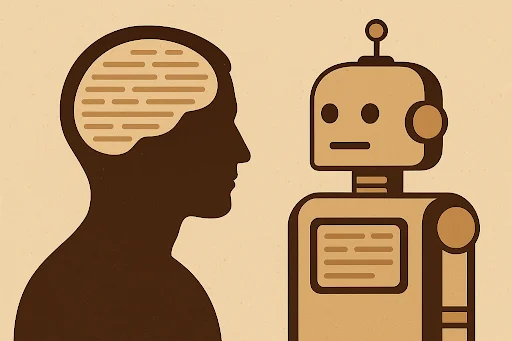The internet today feels oddly familiar, no matter where you look. Blog posts, news updates, student essays, and product reviews increasingly follow the same rhythm: polished, coherent, but strangely predictable. That sameness is no accident. Generative AI systems, while powerful, are trained on vast pools of existing text and optimized to produce safe, “middle-of-the-road” content. This consistency is useful for scaling communication, but it raises an uncomfortable question: what happens when everything starts to sound the same? The answer goes beyond style—it affects culture, creativity, trust, and even how knowledge is shared.
What Is AI Writing and Why Does It Matter?
AI writing refers to the use of large language models (LLMs) such as GPT, Claude, or Gemini to generate written content. These systems rely on probability to predict the next word in a sequence, guided by parameters like perplexity (how surprising text appears) and burstiness (variation in sentence structures). The result is readable, coherent text that often feels human but lacks the edge of lived experience.
The appeal is clear: faster content production, reduced costs, and an easy way to fill websites, marketing campaigns, and academic submissions. But at scale, this uniformity risks diluting cultural diversity and originality.
The Human Element: Why Voice Still Matters
Original human writing introduces unpredictability, nuance, and lived perspective. A sentence can reflect personality through rhythm, word choice, or cultural reference in ways AI cannot authentically replicate. Readers pick up on this distinction, which is why humanize ai solutions are gaining traction. These tools refine or rewrite AI-generated drafts to restore tone, originality, and authenticity. They don’t reject automation outright—they bridge the gap between efficiency and human creativity.
The Myth of Infinite Creativity in AI
One common misconception is that AI can create endlessly unique work. In reality, it is bounded by the patterns and biases of its training data.
- Myth: AI has unlimited originality.
- Reality: AI recombines existing ideas, often recycling clichés.
- Myth: AI always saves time.
- Reality: Editing “generic” AI output often takes longer than drafting original work.
- Myth: Readers cannot tell the difference.
- Reality: Studies show that readers subconsciously notice when text lacks personal voice or context.
How Sameness Plays Out Across Contexts
Students
Students using AI to draft essays often produce formulaic arguments. While these might pass basic grading rubrics, they risk losing critical thinking and the personal reflection teachers value.
Professionals
Marketing copy written by AI often defaults to buzzwords, creating content that blends into the noise. For industries built on brand differentiation, this undermines strategic positioning.
Publishers and Journalists
The media industry has already seen cases where AI-generated articles needed retractions due to factual errors or plagiarism. Standardized style also weakens trust in journalism.
Businesses
For businesses, AI-driven content can flood blogs with SEO-friendly posts, but when everyone uses the same tools, rankings flatten, and authentic thought leadership suffers.
Comparing AI Writing vs Humanized Writing
| Feature | AI Writing (Unedited) | Humanized Writing / Humanize AI |
|---|---|---|
| Tone | Generic, risk-averse | Contextual, audience-specific |
| Accuracy | May hallucinate facts | Verified and fact-checked |
| Cultural nuance | Often misses local context | Captures lived experience |
| SEO impact | Short-term ranking boost | Long-term authority building |
| Cost | Low upfront cost | Higher editing investment, but stronger ROI |
Practical Guidance: What Creators and Readers Can Do
- For Writers: Use AI as a drafting partner, but always add your own layer of originality, references, or personal stories.
- For Businesses: Combine AI efficiency with human oversight to maintain brand voice and trustworthiness.
- For Educators: Encourage students to treat AI as a brainstorming tool rather than a replacement for critical analysis.
- For Publishers: Establish transparency policies—disclose when AI assists in content creation and implement editorial review layers.
Looking Ahead: The Next 1–3 Years
AI writing will not disappear; it will evolve. Expect:
- Better Detection: Tools using metadata analysis, semantic fingerprints, and perplexity scoring will improve.
- Integrated Humanization: Businesses will increasingly adopt hybrid models where AI produces drafts and humanizers refine them.
- Policy Shifts: Institutions from universities to regulators will create stricter guidelines for AI use in authorship.
- Cultural Pushback: Audiences will seek more authentic voices, rewarding creators who lean into personal style.
Key Takeaways
- AI writing saves time but risks cultural homogenization.
- Myths about AI originality obscure its limitations.
- Sameness affects students, professionals, publishers, and businesses differently, but always reduces trust.
- Human oversight and tools that humanize AI output restore credibility and cultural value.
- The future will demand balance, not replacement: efficiency paired with authenticity.
FAQs
- How can I tell if content was written by AI?
Look for overly polished phrasing, lack of specific details, and repetitive sentence structures. Detection tools can assist, but reader intuition often spots the difference. - Is AI writing bad for SEO in the long run?
Yes, if overused. Search engines increasingly prioritize originality, authority, and user value. Identical AI-generated posts dilute rankings over time. - What is the role of “humanize AI” tools?
They refine AI drafts by adding nuance, adjusting tone, and ensuring accuracy—helping writers maintain efficiency without sacrificing authenticity. - Should students use AI for assignments?
Only as an aid for brainstorming or structuring ideas. Relying fully on AI risks academic dishonesty and weakens learning outcomes. - Will AI ever write as creatively as humans?
Unlikely. While models may simulate style better, they lack lived experience, emotional depth, and cultural intuition. - How should businesses adapt to AI writing?
Adopt a hybrid strategy: let AI handle repetitive tasks, but ensure human review for anything brand-critical or customer-facing.


